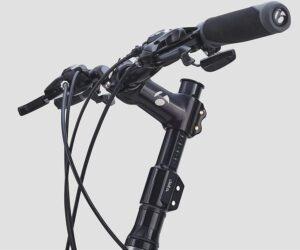There are several ways by which we can adjust bike fit for a more comfortable or efficient riding position, or better handling and control while riding. In an ideal scenario, bike fit should be dialed in by means of a session in a professional fitting studio.
This enables you to get an either a baseline fit that would allow you to purchase your correct frame size, or fine tune your bike for a better fit.
Alas, it is not always possible to get professional bike fit. Fitting sessions are expensive, and not everyone lives within a reasonable distance from a good bicycle fitting studio.
Additionally, sometimes we also need to make fit adjustments on a budget, perhaps to make a spare bike fit for use by a family member, or to change the riding position on bikes we already own.
 One of the most common complaints about bike fit is that the handlebars are too low or that the rider feels they’re too stretched out. There are several ways the handlebar position could be adjusted, including stems with a higher degree of rise, adding spacers below the stem or using higher handlebars with a higher degree of rise.
One of the most common complaints about bike fit is that the handlebars are too low or that the rider feels they’re too stretched out. There are several ways the handlebar position could be adjusted, including stems with a higher degree of rise, adding spacers below the stem or using higher handlebars with a higher degree of rise.
Sometimes, though, we run into the problem of needing to raise the handlebars more than the aforementioned options allow. This is especially true when it comes to commuter bikes, or when trying to adjust the fit for an older rider or someone with poor mobility.
Also, with some bikes, the fork’s steer tube might have been cut at a length that does not allow adding spacers below the stem. To further raise the handlebar in such situations, two additional options are available: using a bike stem riser (also known as a stem extender) or an adjustable stem.
In the paragraphs that follow we explain the difference between those two parts, discuss how to determine choice of one over the other, and address a common question which is: are stem risers safe to use?
Bike stem riser (stem extender)
A stem riser is a hollow tube designed to fit over your fork’s steer tube where it goes above your bike’s head tube by means of pinch bolts similar to what you would see on standard threadless stems, effectively extending the length of your steer tube and putting the rider in a much more upright position.

Stem risers are fairly easy to fit to the bike if you are comfortable with working on bikes and have the required tools, but there are things to keep in mind. While things like riser handlebars and stems with a steeper degree of rise can add a couple of inches of height to your handlebars, stem risers can raise the handlebars by up to a whopping six inches (15cm).
With such a significant increase in handlebar height, the existing shifter and brake cables might be too short for the new position, and swapping them out with longer cables may be required which makes it a more difficult and time consuming job than a simple stem swap.
When to consider using a stem riser?
A stem riser will be a good solution for bikes with a steer tube that has been cut too short and requires adding significant height to the handlebar position. If fitted correctly, they work well for the intended purpose, but do keep in mind that the handlebar ends up in a fairly fixed position and on-the-fly adjustment will not be possible, so do make sure the new position will fit whoever will be appropriate for the rider (sometimes micro-adjustment is possible with spacers, but that entirely depends on the length of your steer tube and the type of stem riser you are using)
Recommended stem riser: Delta Cycle Bike Stem Extender
Adjustable stem

Adjustable stems are, just as their name imply, stems which could be adjusted up and down without removing them from the bike or moving any spacers. Most adjustable stems come in pretty much the same basic design: there is an upright part that clamps to your steer tube just like standard fixed stems, but instead of the fixed stem “neck”, there is a hinge with bolts that could be loosened for adjusting the stem angle up or down.
Adjustable stems are just as easy to fit as standard stems, and once on the bike, all you need to do to change the handlebar height is to follow the steps in manufacturer user manual which would essentially involve loosening one or two bolts, setting stem rise, then retorquing the bolt(s) to recommended spec.
When to consider an adjustable stem?
Adjustable stems make it a breeze to change the riding position on the bike with a simple hex wrench. If you have a bike that you often let family members and visitors to your home use, this would be a great way to very quickly make the bike fit them better. Adjustable stems make sharing a bike among several people very easy.
Recommended adjustable stem: Ritchey 4-Axis Adjustable stem
Final words: Are stem risers and adjustable stems safe to use?
Generally speaking, the more moving or separate parts something has, the more prone it would be to mechanical issues. This holds true when comparing fixed stems and one-piece steer tubes to stem risers and adjustable stems.
The latter are add-on parts and there is the risk of things coming loose and, given the critical function they perform, this would pose a safety hazard to the rider.
Another concern is that with the significant height added to the handlebar using those components, the rider puts more leverage on the steer tube/head tube area, and sometimes there is a risk of this additional leverage exceeding the original specs or manufacturer safe use recommendations and potentially resulting in a dangerous parts failure.
If you have to use one of those two options to adjust the bike fit, it is highly recommended that:
- Buy high quality, durable parts made by well-known manufactures. Even if you spend a bit more money compared to off-brand parts, you will have the peace of mind that this critical component has been made with strict adherence to safety standards
- If you are not experienced with wrenching on bikes, take it to your local bike shop who will not only be able to fit the parts properly, but also advise on any potential safety issues as explained above.
- Do not use these parts on bikes that are used for athletic cycling, such as road race bikes or mountain bikes.
- Regularly inspect the tightness and condition of adjustable stems and stem risers

Hani Morsi is a seasoned multi-discipline cyclist with a particular liking for mountain and gravel bikes. Hani is also a mountain bike coach, trail builder and experienced bike mechanic.

![[PART 3] EXTENDED GEARING FOR THE ROAD BIKE [PART 3] EXTENDED GEARING FOR THE ROAD BIKE](https://biketestreviews.com/wp/wp-content/uploads/2018/01/IMG_20180122_174050941-500x300.jpg)
